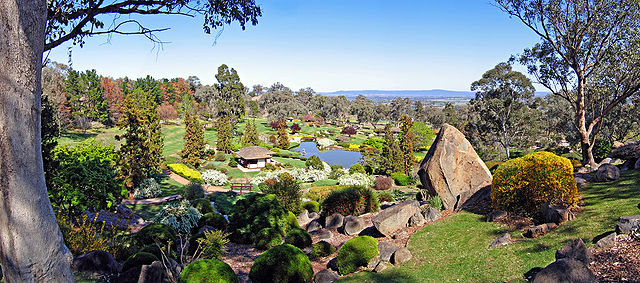Cowra
town in New South Wales, Australia From Wikipedia, the free encyclopedia
town in New South Wales, Australia From Wikipedia, the free encyclopedia
Cowra is a city in the central west of New South Wales, Australia. It is in Cowra Shire. It is 310m above sea-level and about 300 km west of Sydney. Cowra is on the banks of the Lachlan River.
| Cowra New South Wales | |||||||||
|---|---|---|---|---|---|---|---|---|---|
From top to bottom, left to right: Kendal Street divides the CBD, the Eastern entrance to the town, the Japanese War Cemetery, Crops of canola create 'fields of gold', decorated in Aboriginal art, the pylons of the Cowra Bridge, Australia's World Peace Bell and the Lachlan River which flows through the heart of the town | |||||||||
| Coordinates | 33°50′6″S 148°41′33″E | ||||||||
| Population | 10,063 (2016 census)[1] | ||||||||
| Established | 1846 | ||||||||
| Gazetted | 1849 | ||||||||
| Postcode(s) | 2794 | ||||||||
| Elevation | 310 m (1,017 ft) | ||||||||
| Time zone | AEST (UTC+10) | ||||||||
| • Summer (DST) | AEDT (UTC+11) | ||||||||
| Location | |||||||||
| LGA(s) | Cowra Shire | ||||||||
| County | Forbes, Bathurst | ||||||||
| State electorate(s) | Cootamundra | ||||||||
| Federal division(s) | Riverina | ||||||||
| |||||||||
The first name for Cowra was Coura Rocks. This may have been the name of one of the first cattle farms. This name is probably the name of the river ford (crossing) where people could cross the Lachlan River.
The name Cowra comes from a local aboriginal word meaning "eagle on the rocks".
It should not be confused with another New South Wales town named Corowa.

The first people to live in the area were the Wiradjuri people. The first European explorer, George Wilson Evans, came into the Lachlan Valley in 1815. He named the area the Oxley Plains after his boss, the Surveyor-General, John Oxley. In 1817 he said the area was "unfit for white settlement". An army camp was set up soon after at Soldiers Flat near present-day Billimari. Arthur Ranken and James Sloan, from Bathurst, were amongst the first European settlers on the Lachlan. They moved to the area in 1831.
The township of Coura Rocks began in 1840. By 1847 the township was called Cowra. The village was officially listed in 1849.
In the 1850s many people looking for gold went through on their way to the gold fields at Lambing Flat (Young) and Grenfell. The first school was started in 1857. The first bridge over the Lachlan River was built in 1870. Gold was found at Mount McDonald in the 1880s. The railway, from Sydney, reached Cowra in 1886. Local government started in 1888. The first telephone were connected in 1901. The town water supply was started in 1909, the gas in 1912, and town supplied electricity was connected in 1924.
Cowra is home to the Australian copy of the United Nation's World Peace Bell. These are normally kept in a nation's capital city. It was given to Cowra because of its special role in international understanding, world peace and as a centre of world friendship.

During World War II Cowra was the site of a prisoner of war (POW) camp. Most of the prisoners were captured Japanese and Italian soldiers, sailors and airmen. On August 5, 1944 about 545 (some sources say over 1000) Japanese POWs attempted a mass escape from the camp. This is perhaps the largest prison escape in the world. At the same time, other Japanese prisoners killed themselves, or were killed by their countrymen, inside the camp.
The POWs tried to capture machine gun posts, armed only with home made weapons. The Prime Minister John Curtin said this was a "suicidal disregard of life", and had no chance of success.
During the escape 231 Japanese and 4 Australian guards were killed, and 108 prisoners were wounded. The dead Japanese were buried in Cowra in a specially made Japanese War Cemetery. This is the only such cemetery in Australia. It also has some of the dead from the WWII air raids on Darwin.
An Avenue of Honour also remembers those who died in World War I.
The Japanese War Cemetery was looked by members of the Cowra RSL and given to Japan in 1963. In 1971 the Cowra Tourism Development decided to celebrate this link with Japan. They planned a Japanese garden for the town. The Japanese Government agreed to help as a sign of thanks for the respectful treatment of their war dead. The garden also received money from the Australian Government and private groups.
The garden was designed by Ken Nakajima (1914 - 2000). He was a world famous designer of Japanese gardens. The first part was opened in 1979, with a second part opened in 1986.
The gardens were built in the style of the Edo period. They are a kaiyū-shiki or strolling garden. They are designed to show all of the landscape types of Japan. At five hectares, the Cowra Japanese Garden is the largest Japanese garden in the Southern Hemisphere. An annual Sakura Matsuri (cherry blossom festival) is held in the gardens during late September and/or early October each year. The garden also has other events during the year.
 |
 |
 |
Seamless Wikipedia browsing. On steroids.
Every time you click a link to Wikipedia, Wiktionary or Wikiquote in your browser's search results, it will show the modern Wikiwand interface.
Wikiwand extension is a five stars, simple, with minimum permission required to keep your browsing private, safe and transparent.